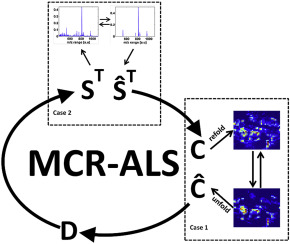当前位置:
X-MOL 学术
›
Anal. Chim. Acta
›
论文详情
Our official English website, www.x-mol.net, welcomes your feedback! (Note: you will need to create a separate account there.)
Application of a sparseness constraint in multivariate curve resolution – Alternating least squares
Analytica Chimica Acta ( IF 6.2 ) Pub Date : 2018-02-01 , DOI: 10.1016/j.aca.2017.08.021 Siewert Hugelier , Sara Piqueras , Carmen Bedia , Anna de Juan , Cyril Ruckebusch
Analytica Chimica Acta ( IF 6.2 ) Pub Date : 2018-02-01 , DOI: 10.1016/j.aca.2017.08.021 Siewert Hugelier , Sara Piqueras , Carmen Bedia , Anna de Juan , Cyril Ruckebusch

|
The use of sparseness in chemometrics is a concept that has increased in popularity. The advantage is, above all, a better interpretability of the results obtained. In this work, sparseness is implemented as a constraint in multivariate curve resolution - alternating least squares (MCR-ALS), which aims at reproducing raw (mixed) data by a bilinear model of chemically meaningful profiles. In many cases, the mixed raw data analyzed are not sparse by nature, but their decomposition profiles can be, as it is the case in some instrumental responses, such as mass spectra, or in concentration profiles linked to scattered distribution maps of powdered samples in hyperspectral images. To induce sparseness in the constrained profiles, one-dimensional and/or two-dimensional numerical arrays can be fitted using a basis of Gaussian functions with a penalty on the coefficients. In this work, a least squares regression framework with L0-norm penalty is applied. This L0-norm penalty constrains the number of non-null coefficients in the fit of the array constrained without having an a priori on the number and their positions. It has been shown that the sparseness constraint induces the suppression of values linked to uninformative channels and noise in MS spectra and improves the location of scattered compounds in distribution maps, resulting in a better interpretability of the constrained profiles. An additional benefit of the sparseness constraint is a lower ambiguity in the bilinear model, since the major presence of null coefficients in the constrained profiles also helps to limit the solutions for the profiles in the counterpart matrix of the MCR bilinear model.
中文翻译:

稀疏约束在多元曲线解析中的应用——交替最小二乘法
在化学计量学中使用稀疏性是一个越来越受欢迎的概念。最重要的是,其优点是获得的结果具有更好的可解释性。在这项工作中,稀疏性被实现为多元曲线分辨率的约束 - 交替最小二乘法 (MCR-ALS),其目的是通过具有化学意义的双线性模型再现原始(混合)数据。在许多情况下,分析的混合原始数据本质上并不稀疏,但它们的分解曲线可能是这样的,就像在某些仪器响应中的情况一样,例如质谱,或者在与粉末样品的分散分布图相关联的浓度曲线中高光谱图像。为了在受约束的轮廓中引起稀疏,一维和/或二维数值数组可以使用对系数进行惩罚的高斯函数的基础进行拟合。在这项工作中,应用了具有 L0 范数惩罚的最小二乘回归框架。该 L0 范数惩罚限制了受约束数组拟合中非零系数的数量,而没有对数量及其位置的先验。已经表明,稀疏约束会抑制与 MS 光谱中的无信息通道和噪声相关的值,并改善分布图中分散化合物的位置,从而更好地解释受约束的轮廓。稀疏约束的另一个好处是双线性模型中的模糊性较低,
更新日期:2018-02-01
中文翻译:

稀疏约束在多元曲线解析中的应用——交替最小二乘法
在化学计量学中使用稀疏性是一个越来越受欢迎的概念。最重要的是,其优点是获得的结果具有更好的可解释性。在这项工作中,稀疏性被实现为多元曲线分辨率的约束 - 交替最小二乘法 (MCR-ALS),其目的是通过具有化学意义的双线性模型再现原始(混合)数据。在许多情况下,分析的混合原始数据本质上并不稀疏,但它们的分解曲线可能是这样的,就像在某些仪器响应中的情况一样,例如质谱,或者在与粉末样品的分散分布图相关联的浓度曲线中高光谱图像。为了在受约束的轮廓中引起稀疏,一维和/或二维数值数组可以使用对系数进行惩罚的高斯函数的基础进行拟合。在这项工作中,应用了具有 L0 范数惩罚的最小二乘回归框架。该 L0 范数惩罚限制了受约束数组拟合中非零系数的数量,而没有对数量及其位置的先验。已经表明,稀疏约束会抑制与 MS 光谱中的无信息通道和噪声相关的值,并改善分布图中分散化合物的位置,从而更好地解释受约束的轮廓。稀疏约束的另一个好处是双线性模型中的模糊性较低,



























 京公网安备 11010802027423号
京公网安备 11010802027423号